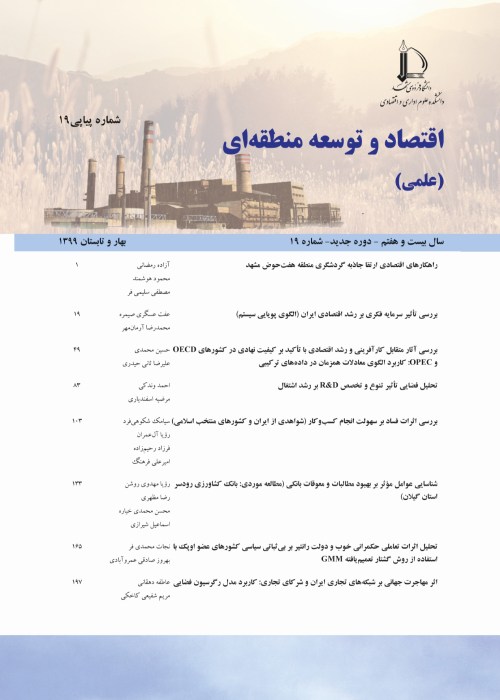Analyzing the effective strategic factors on provinces competitiveness in national tourism development
Author(s):
Article Type:
Research/Original Article (دارای رتبه معتبر)
Abstract:
Introduction
Considering the benefits of national tourism industry development, many studies identified effective factors on tourism attraction. But most of these studies focus on foreign tourists and believe income and exchange rate are effective in tourist attraction. While due to Michel Porter’s theory (1990), competitive advantage, to develop tourism industry first domestic tourism should be in consider. Porter believes the industries could succeed the global competition that, the firms of the industry promote their performance and ability by creating competition within the country. So, different region’s competition within the country is important in tourism industry development.These items emphasize to consider the effective factors on different provinces' competitiveness about tourist attraction. So the study answers these questions: Which factors are effective on provinces competitiveness in tourist attraction and national tourism industry development? Which are the priorities of national tourism development due to the interactional effect between factors and long run casual relations?
Theoretical framework
Based on theoretical framework, there are two approaches in analyzing effective factors on tourism attraction. First approach is demand – driven ,which is due to the assumption that “ the destination provocates people satisfactory emotions and believes and meet their need”( Hu & Ritchie(1993)).On the other hand the supply – driven approach in tourism industry focuses on services which are prepared and designed for the tourists of the destination.The above approaches in different studies has been done in various forms. Based on the literature the effective factors on the number of the tourists divides in to four groups, the first group is related to the supply side factors including infrastructures like nation’s accommodation, transportation infrastructure, health and government credits. The Second group is related to educational and medical potentials and cultural and natural attractions. The third group includes tourism region features like population and Geographical distance, the fourth group is related to the tourist’s individual characteristics like income.
Methodology
According to the theoretical framework and previous studies, the analyzing model presented below:(1) Here t shows the time, i is the province also TU, HO, TWA, BE, HS, CR, NCU, EDU, DS, NI, PU and DI are respectively number of the tourists. The total number of nation’s accommodation ,main roads length including highways and freeways in terms of Kilometer, health index in terms of the number of beds of province’s medical centers, health index in terms of specialist , government’s province’s development credits in terms of billion riyals, the number of cultural centers , the number of university students. Dummy variable is for Northern provinces and Tehran, province’s per capita income (except destination province), population and Geographical distance. To evaluate the above model, panel data approach with the information of 31 provinces of Iran during (2011-2014) is used.
After model estimation and determining the share of each factor, factors long run relation and causality direction of each effective factor on tourism attraction is analyzed by using Johansen-Juselius cointegration test and error correction models (1990) .So each factor's position among the other factors is specified .As there are many factors which are used in the base model to analyze public infrastructures and provinces attractions. So in analyzing long run relations and causality direction among factors the principle component approach is used to extract a factor for the infrastructures and another factor for attractions.
Results & Discussion
The results in the form of panel data and due to normalized factors show that supply side factors (the number of Nation's Accommodations and public infrastructures) comparing to demand side factors (artistic, cultural and natural attractions and target province’s health facilities) play an important role on tourists final decision. Then by analyzing interactions between tourism effective factors and long term relationships due to Johansson’s cointegration approach and error correction models , long term casual relationship is approved from the number of nation’s accommodation and public infrastructures toward tourism attractions and the number of tourists. These results show that among the tourism effective factors, generating public facilities and encouraging privet sector to establish accommodation by provincial authorities has a strategic role in promoting tourism attraction and developing province’s tourism industry.
Conclusions & Suggestions
The results of the study emphasizes on tourism infrastructures and the government’s key role. In addition the nation's accommodation construction, which usually built by private sector, cause tourist attraction and has a main role in tourism industry development which increases by government’s policies and encouragements.Due to the importance of competition among provinces in national tourism development, the study results emphasize the necessity to pay attention to provinces' balanced allocation of public facilities for competition creation among provinces to attract tourist. In other words, if distribution inequality of facilities and public infrastructures among provinces decreases, deprived provinces capacity of tourist attraction will increase and this will reinforce the competition of tourist attraction among provinces.
Deprived provinces enjoyment of public facilities lead to recognition of tourism attractions and these provinces' competition will upgrade which causes tourism attraction reinforcement.
Keywords:
Language:
Persian
Published:
Journal of Economy and Regional Development, Volume:25 Issue: 16, 2019
Pages:
124 to 150
magiran.com/p1967973
دانلود و مطالعه متن این مقاله با یکی از روشهای زیر امکان پذیر است:
اشتراک شخصی
با عضویت و پرداخت آنلاین حق اشتراک یکساله به مبلغ 1,390,000ريال میتوانید 70 عنوان مطلب دانلود کنید!
اشتراک سازمانی
به کتابخانه دانشگاه یا محل کار خود پیشنهاد کنید تا اشتراک سازمانی این پایگاه را برای دسترسی نامحدود همه کاربران به متن مطالب تهیه نمایند!
توجه!
- حق عضویت دریافتی صرف حمایت از نشریات عضو و نگهداری، تکمیل و توسعه مگیران میشود.
- پرداخت حق اشتراک و دانلود مقالات اجازه بازنشر آن در سایر رسانههای چاپی و دیجیتال را به کاربر نمیدهد.
In order to view content subscription is required
Personal subscription
Subscribe magiran.com for 70 € euros via PayPal and download 70 articles during a year.
Organization subscription
Please contact us to subscribe your university or library for unlimited access!


